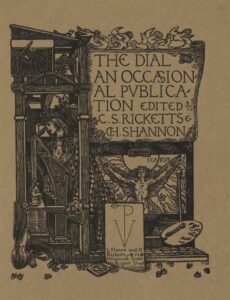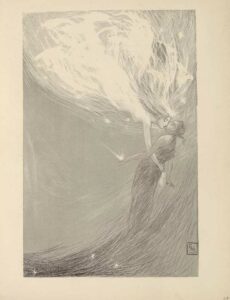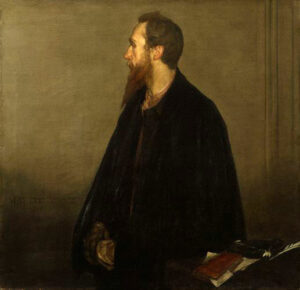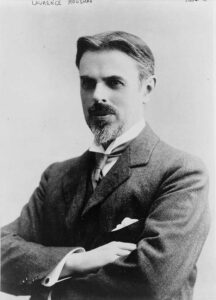The Case of the Child in “A Glimpse of Heaven” and “Open the Door, Posy!”
© 2019 Alexandra Monstur, Ryerson University

Introduction:
According to Professor Marah Gubar in “The Victorian Child, c. 1837-1901,” the conception of childhood as a space for fanciful imaginings, innocence, and happiness was a dominant rule of thought within Victorian Britain—one that had canonized itself as a societal norm as class distinctions within the nation grew by way of the Industrial Revolution (pp 1-2). However, this period of the 1890s within Britain was simultaneously a time marked by dissatisfaction and critique against such norms. It must be noted that such modes of insurgency took the form of veiled discourse—often through literary means; in the introduction to “Social Protest Literature of Victorian England”, editors Jessica Bomarito and Russel Whitaker note that, “The idea of using the powers of literature to effect social change took on a new shape in England in the 1830s, and continued into the 1850s and beyond.” A prolific example of this can be found in the literary magazines that rose to prominence during this time; one such publication, The Dial (1889-1897), was a reflection of this notion, as it contained fantasy stories and art that subtly promulgated subversive ideas, and was crafted by artists who themselves lived subversive lifestyles. In his overview essay for the work, Koenraad Claes quotes Charles Ricketts, in affirmation of this notion: “‘The sole aim of this magazine is to gain sympathy with its views.’” Such is typified through two specific Dial publications: “A Glimpse of Heaven”, written by co-editor Charles Ricketts (volume 1), and “Open the Door, Posy!”, written by Laurence Housman (volume 5); both operate within the fantasy genre and thus achieve the means of veiled discourse. By extension, both “A Glimpse of Heaven” and “Open the Door, Posy!”—centred around the fantastical experiences of two young, impoverished girls—work to reject the active Victorian conception of childhood; in doing so, they reveal the reality of 1890s British society: children are not afforded an idealized upbringing, so long as they are from the lower-class.
Fantasy as a Means of Critique
However, in order to properly ascertain these ideas, the notion of fantasy as a means of critique must firstly be explored. In Spectrum of Decadence: The Literature of the 1890s, Murray Pittock discusses how, during the 1890s, two popular literary traditions were in use—and were often portrayed throughout the literary magazines of the period such as The Dial; these two traditions are denoted as being that of Symbolism and Decadence (6). Often overlapping, Symbolism and Decadence operate around the central feelings of dissatisfaction with materiality and corporeality—they also take issue with many societal norms (4). As such, it can be understood that both traditions often utilize the nature of the unreal, the fantastic, and the supernatural as a method of subtly revealing their authors’ societal critiques and true desires for change—especially when one thinks back to Charles Ricketts’s statement in volume 1 of The Dial, in which he argues that the aim of the magazine is to cultivate a sympathy within its readers concerning its views (Claes). As Imperial Britain was founded primarily on Judaeo-Christian values and staunch traditionalism (Steinbach 260), outright questioning of such norms was arguably often frowned upon; as such, fantasy (as a product of Symbolism/Decadence) became a corrective means for castigating what the authors working within these respective traditions believed to be societal ills.
Class and the Myth of Childhood in Victorian Britain
With this in mind, the idea of Victorian constructions of childhood—and the contradiction such constructions pose—must also be expanded upon. As aforementioned, childhood came to be conceptualized as a space for perfect innocence, lack of responsibility, and play during the Victorian era; Jeanette Sky, in the abstract for “Myths of Innocence and Imagination: the Case of the Fairy Tale,” says as much, “Childhood came to represent an elevated imaginary state (. . .) [and] the Victorians created a powerful, but also problematic myth of childhood.” As growth of infrastructure, economy, and urban city centres (as a result of the Industrial Revolution) occurred within Britain, children began to be regarded as a protected class of sorts—individuals saw the need for children to be removed and relegated to spaces separate from the evils and corruptions that characterized adult life (Gubar 1). However, this conception is arguably due to the increase in disparities between the upper and lower class systems operating within Britain during this time—Prince Albert, Queen Victoria’s husband, is quoted as saying that “the working man’s children were ‘part of his productive power’” (Gubar pp 1-2). Thus, because middle-to-upperclass families could afford to provide their children with the means for obtaining such an idealized version of childhood, it is no wonder that this conception took such deep roots within Victorian society.
This comes to reveal the great antithesis to the Victorian conceptualization of childhood: that being the reality for children who lived as low-class individuals within 1890s Britain. For lower-class children at this time, it can be noted that their experience was vastly different to children belonging to the upperclass. Children living within this social set experienced impoverished conditions, and were subject to famine and sickness—which, in many cases, led to death. Meanwhile, the children who did manage to stave off ill health were often subject to abuse that was physical and sexual in nature (Gubar pp 1, 5). Additionally, Sarah Seaton, in Childhood & Death in Victorian England, outlines the practice of child farming, another societal ill that lower-class children were subject to: “Liverpool children aged between nine and 14 were sent to silk, worsted, flax, and cotton mills, and were employed in industries such as bobbin manufacturing (. . .) increasing their risk of death from an industrial injury” (2). Thus, a new canon of the Victorian child comes into fruition—the idea of children as dispensable labourers who have no choice other than to exist within these endangering conditions. For them, they are not afforded the fantasy and lack of responsibility that the Victorian construction of childhood has so promulgated; instead, they are thrust into a pseudo-adulthood, driven by need, hunger, and overall lack.

The Stories in Context
Given the socio-historical context, “A Glimpse of Heaven” and “Open the Door, Posy!” are two stories that stand situated within this idea of fantasy being utilized as a medium for social critique. Support for this can be found by examining aspects of the contents of each volume from which the texts come. “A Glimpse of Heaven,” is in the first volume (1889) along with a story entitled “The Cup of Happiness” (58)—also written by Charles Ricketts. This story features the demon Lilith from Jewish folklore (“Lilith”). This stands as significant, seeing as the inclusion of a story featuring a nontraditional system of belief—given the largely Judaeo-Christian context under which these stories were written—suggests to its readers that the author is challenging religious norms in presenting a new spiritual lens through which to view the world. With this notion in mind, one can also see “A Glimpse of Heaven” as a story that Ricketts is using as a medium through which to look at things anew; however, with this text, Ricketts’s goal is arguably to examine the status and treatment of lower-class children within fin-de-siècle Britain.
As for “Open the Door, Posy!”, situated within its respective fifth volume, is a piece of artwork entitled “Ruth, Orpah, and Naomi” (66). This artwork alludes to the Old Testament book of Ruth in the Bible (“Ruth”). Such a display of Christianity in this artwork is juxtaposed (in the volume) with the more pagan expression of the supernatural in Housman’s “Open the Door, Posy!”—and thus speaks to the nuance of belief and practice that was occurring during the social and spiritual insurgency of the British 1890s. In such a portrayal, one can see how “Open the Door, Posy!” is yet another instance of fantasy being utilized as a means of critique; its spiritual antithesis to the traditionalist beliefs depicted through “Ruth, Orpah, and Naomi” arguably come to stand as a symbolic antithesis to the prevailing treatment and status of the impoverished children of Britain’s working-class.

Speaking to Situation: “A Glimpse of Heaven” and “Open the Door, Posy!”
In Ricketts’s story, “A Glimpse of Heaven” —a highly sentimental fantasy that arguably flows in the same vein as Hans Christian Andersen’s “The Little Match Girl”—this rejection of the Victorian myth of childhood is firstly accomplished through the author’s denotation of the position his protagonist (a poor, unnamed little girl) holds within her family. In the opening lines of the story, readers become immediately aware of the fact that this little girl is clearly operating as a caretaker for her family unit; her father is an alcoholic who squanders their money, and there is repeated mention of the girl having younger sisters, who are dependent on her (pp 20, 22). There is also mention of the fact that the girl’s mother is dead (20)—which only further solidifies her place as a primary caretaker within her family. The significance of this is as follows: in placing a child in the role of primary caretaker, Ricketts highlights a reality: the lower-class child does not have access to the idealized experience outlined by the Victorian construction—many of them exist within an adult space despite their lack of biological maturity. In this sense, the line between child and adult becomes blurred, ultimately working as a rejection of the conception of childhood. By extension, Ricketts’s rejection stands as a revelation concerning the lower-class child of Victorian England: they are not protected, or looked after—certainly not by their society, and, in many cases, their families—and, above all, they do not experience this cultivated narrative of childhood.

Likewise, Housman’s “Open the Door, Posy!” also works within this same critical lens—albeit in a more darkly humorous fashion. Posy, the main character, is already dead as the story commences (4); however, her actions in her subsequent state of pseudo-resurrection point once more to the idea that the author is aiming to reject Victorian notions of childhood. This is evidenced through Posy’s self-sufficiency—exemplified through her theft of the bread in order to pay Death the Taxman for her and her mother’s burial (4). Her atypical independence, at such a young age, arguably acts as a subversion of the innocence narrative that is emphasized throughout the period’s ideas of what marks childhood as a separate, sacred space—and aligns with the fact that the majority of lower-class children were forced to occupy adult spaces in 1890s Britain. Furthermore, Posy being a victim to both famine and illness (4) is another means of rejecting traditional constructions of childhood, as starvation and sickness are generally seen as products of a cruel, corrupt world—a world in which the typified innocent child has no place, according to Victorians (Sky). Therefore, through Posy’s self-sufficiency, starvation, and sickness-induced death, Housman not only rejects constructions of childhood, he also points—as Ricketts does—to the fact that lower-class children are barred from the innocence, peace, and happiness of such an idealized upbringing.
The greatest elements of fantasy in both stories—as exhibited through their life-after-death narratives—are also effective opposers to the Victorian narrative surrounding childhood. In “A Glimpse of Heaven,” the little girl dies while waiting outside the pub for her father, and experiences a transfiguration in which her spirit is taken up to heaven. There, she encounters God and his angels; however, her concern still clearly lies with her sisters—she states that she wishes they would be able to join her in this place of complete paradise. In response to her request, God encourages the little girl to “be at peace”, and with that, the story comes to its conclusion (pp 21-22). This is significant, as Ricketts creates a narrative in which the only peace and happiness that the little girl is able to achieve is through this transfigured status—ultimately, it is only in heaven that she can be loosed from her suffering, and truly be a child, free of the earthly responsibilities that plagued her corporeal state. Similar ideas are put forth in Housman’s “Open the Door, Posy!” Posy’s happy ending—unlike the little girl’s in “A Glimpse of Heaven”—is ultimately achieved when she and her mother succeed in cheating death by refusing to pay all three of its incarnations; instead, Posy’s mother urges her to “close the door” (pp 6-7). Thus, through the act of closing the door on death itself, Posy is able to reach a transfigured state: “And when they came to life again they found themselves quite well and hearty (. . .) and the fever was gone from the town, and the famine was over” (6). In such, Posy can now live out the idealized childhood that was unavailable to her before her death.
Conclusion
To conclude, this idea of the happy ending—solely achieved, in both stories, through the fantastical notion of life’s continuation after death—is paramount. It arguably signifies the fact that it is impossible for both of these children to achieve the same measure of happiness, peace, and childhood fancy that the Victorian model promulgates. To illustrate this idea, both Ricketts and Housman create narratives in which both girls clearly occupy adult spaces, and are restricted to living out experiences that go against the norms of childhood innocence and lack of responsibility. In “A Glimpse of Heaven,” this is illustrated through the little girl acting as caretaker for her alcoholic father and two sisters; in “Open the Door, Posy!” this is revealed through Posy’s self-sufficiency, theft of the bread, and her death as a result of plague and starvation. It is clear, then, that both girls—in life—were never able to attain the hallmarks of traditional childhood. As such, these ideas work to not only reject the Victorian construction of childhood; they also act as a means of highlighting fin-de-siècle reality: the child, in essence, does not have access to this protection and idealized experience, so long as they are of a low social set.
Works Cited
Andersen, Hans Christian. “The Little Match Girl.” Internet Archive, http:// www.shortstoryamerica.com/pdf_classics/andersen_little_match_girl.pdf
Claes, Koenraad. “Dial (1889-1897).” C19 Index: Dictionary of Nineteenth-Century Journalism, ProQuest, https://courses.ryerson.ca/d2l/le/content/242471/viewContent/2201829/View
Gubar, Marah. “The Victorian Child c. 1837-1901.” Internet Archive, http:// www.representingchildhood.pitt.edu/pdf/victorian_child.pdf
Housman, Laurence. “Open the Door, Posy!” The Dial, vol. 5, no.1, 1897. pp 4-7. Yellow Nineties 2.0, edited by Lorraine Janzen Kooistra, Ryerson Centre for Digital Humanities, 2019. https://archive.org/details/dial_05/page/n17
“Lilith.” Oxford English Dictionary. 2019. https://en.oxforddictionaries.com/definition/lilith. Accessed 10 March 2019.
Lucian Pizzarro, Ruth, Orpah, and Naomi, in The Dial vol. 5, 1897, p. 65. Yellow Nineties 2.0, edited by Lorraine Janzen Kooistra, Ryerson Centre for Digital Humanities, 2019. https://archive.org/details/dial_05/page/n65
Pittock, Murray. Spectrum of Decadence: the Literature of the 1890s. Taylor and Francis, 2014. Proquest Ebook Central, https://ebookcentral-proquest-com.ezproxy.lib.ryerson.ca/lib/ryerson/detail.action?docID=1757882
Ricketts, Charles. “A Glimpse of Heaven.” The Dial, vol. 1, no.1, 1889. pp 19-22. Yellow Nineties 2.0, edited by Lorraine Janzen Kooistra, Ryerson Centre for Digital Humanities, 2019. https://archive.org/details/dial_01/page/n41
Ricketts, Charles. “The Cup of Happiness.” The Dial, vol. 1, no. 1, 1889. pp 27-33. Yellow Nineties 2.0, edited by Lorraine Janzen Kooistra, Ryerson Centre for Digital Humanities, 2019. https://archive.org/details/dial_01/page/n57
“Ruth.” Oxford English Dictionary. 2019. https://en.oxforddictionaries.com/definition/ruth. Accessed 10 March 2019.
Seaton, Sarah. Childhood and Death in Victorian England, Pen and Sword, 2017. ProQuest Ebook Central, https://ebookcentral-proquest-com.ezproxy.lib.ryerson.ca/lib/ryerson/ detail.action?docID=4915718.
Sky, Jeanette. “Myths of Innocence and Imagination: The Case of the Fairy Tale.” Literature and Theology, vol. 16, no. 4, December 2002. pp 363-376. Internet Archive, DOI: https://doi.org/10.1093/litthe/16.4.363
“Social Protest Literature of Victorian England.” Nineteenth-Century Literature Criticism, edited by Jessica Bomarito and Russel Whitaker, vol. 160, Gale, 2006. Literature Resource Center, http://link.galegroup.com.ezproxy.lib.ryerson.ca/apps/doc/H1410001519/LitRC? u=rpu_main&sid=LitRC&xid=11f22e1d. Accessed 15 Mar. 2019.
Steinbach, Susie. Understanding the Victorians: Politics, Culture and Society in Nineteenth- Century Britain. Routledge, 2017. EBSCOhost, https://web-a-ebscohost- com.ezproxy.lib.ryerson.ca/ehost/ebookviewer/ebook/ bmxlYmtfXzEzNjA1MDZfX0FO0?sid=8ef3d71d-be83-4c14- a918-06012cab09c8@sessionmgr4010&vid=2&format=EB&rid=1
The images used in this exhibit are either in the public domain or being used under fair dealing for the purpose of research and are provided solely for the purposes of research, private study, or education.
